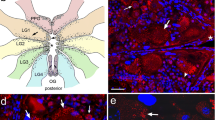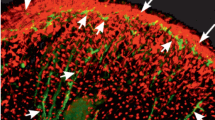Abstract
FMRFamide-like immunoreactivity was detected histochemically in the sea scallopPlacopecten magellanicus. Most immunoreactivity was concentrated in the cerebral, pedal, and parietovisceral ganglia, particularly in the cortical cell bodies and in their fibers which extend into the central neuropile. Whole-mount immunofluorescence studies were used to localize concentrations of immunoreactive cells on the dorsal and ventral surfaces of each ganglion. Immunoreactivity was also detected in nerves emanating from the ganglia. Strong immunoreactivity was localized in peripheral organs, including the gut and gills of juvenile and adult scallops. Weak immunoreactivity was detected in the gonads, heart, and adductor muscle of the adults. A broad FMRFamide-like immunoreactive band of 2.5–8.2 kDa was detected by Western blotting of acetone extracts of the parietovisceral ganglia. In the presence of protease inhibitors, two FMRFamide-like immunoreactive bands (7.2–8.2 kDa and >17 kDa) were obtained. Neither of these bands comigrated with the FMRFamide standard. It is concluded that peptides of the FMRFamide family are probably regulators of numerous central and peripheral functions inP. magellanicus.
Similar content being viewed by others
References
Antheunisse LJ (1963) Neurosecretory phenomena in the zebra musselDreissena polymorpha, Pallas. Arch Neerl Zool 15: 237–314
Austin T, Weiss S, Lukowiak K (1983) FMRFamide effects on spontaneous and induced contraction of the anterior gizzard inAplysia. Can J Physiol Pharmacol 61:949–953
Beninger PG, Le Pennec M (1991) Functional anatomy of scallops. In: Shumway SE (ed) Scallops: Biology, ecology and aquaculture, vol 21 (Development in aquaculture and fisheries science). Elsevier, New York, pp 133–223
Boer HH, Shot LPC, Veenstra JA, Reichelt D (1980) Immunocytochemical identification of neural elements in the central nervous system of a snail, some insects, a fish, and a mammal with an antiserum to the molluscan cardioexcitatory tetrapeptide FMRFamide. Cell Tissue Res 213:21–27
Bright K, Kellet E, Saunders SE, Brierley M, Burke JF, Benjamin PR (1993) Mutually exclusive expression of alternatively spliced FMRFamide transcripts in identified neuronal systems of the snailLymnaea. J Neurosci 13:2719–2729
Buckett KJ, Peters M, Dockray GJ, Van Minnen J, Benjamin PR (1990) Regulation of heartbeat inLymnaea by motoneurons containing FMRFamide-like peptides. J Neurophysiol 63: 1426–1435
Bulloch AGM, Price DA, Murphy AD, Lee TD, Bowes HN (1988) FMRFamide peptides inHelisoma: Identification and physiological action at a peripheral synapse. J Neurosci 8: 3459–3469
Bullock TH, Horridge GA (1965) Structure and function in the nervous systems of invertebrates, vol 2. W.H. Freeman, San Francisco, pp 1390–1431
Candelario-Martinez A, Reed DM, Prichard SJ, Doble KE, Lee TD, Lesser W, Price DA, Greenberg MJ (1993) SCP-related peptides from bivalve mollusks: identification, tissue distribution and actions. Biol Bull, Woods Hole 185:428–439
Chronwall BM, Olschowka JA, O'Donohue TL (1984) Histochemical localization of FMRFamide-like immunoreactivity in the rat brain. Peptides 5:569–584
Cottrell GA, Greenberg MJ, Price DA (1983) Differential effects of the molluscan neuropeptide FMRFamide and related Metenkephalin derivative YGGFMRFa on the tentacle retractor muscle. Comp Biochem Physiol [C] 75:373–375
Cottrell GA, Davies NN, Green KA (1984) Multiple actions of a molluscan cardioexcitatory neuropeptide and related peptides on identifiedHelix neurons. J Physiol 356:315–333
Croll RP (1983) Gastropod chemoreception. Biol Rev 58:293–319
Croll RP (1985) Sensory control of respiratory pumping inAplysia californica. J Exp Biol 117:15–27
Croll RP, Chiasson BJ (1989) Postembryonic development of serotoninlike immunoreactivity in the central nervous system of the snail,Lymnaea stagnalis. J Comp Neurol 280:122–142
Croll RP, Van Minnen J (1992) Distribution of the peptide Ala-Pro-Gly-Trp-NH2 (APGWamide) in the nervous system and periphery of the snailLymnaea stagnalis as revealed by immunocytochemistry and in situ hybridization. J Comp Neurol 324:567–574
Croll RP, Nason J, Van Minnen J (1993) Characterization of neurons in bivalves using antibodies raised against neuropeptides involved in the control of egg-laying in gastropods. Invert Reprod Develop 24:161–168
Dakin WJ (1910) The eye ofPecten. Quart J Microscop Sci 55: 49–112
deWith ND, Schors RC van der (1992) SKPYMRFamide, a novel FMRFamide-related peptide in the snailLymnaea stagnalis. Neurochemistry 3:612–614
Doble KE, Greenberg MJ (1982) The clam rectum is sensitive to FMRFamide, the enkephalins and their common analogs. Neuropeptides 2:157–167
Ebberink RHM, Price DA, Van Looenhout H, Doble KE, Reihm JP, Geraerts WPM, Greenberg MJ (1987) The brain ofLymnaea contains a family of FMRFamide-like peptides. Peptides 8:515–522
Ekström P, Honkanen T, Ebbesson SOE (1988) FMRFamide-like immunoreactive neurons of the nervus terminalis of teleosts innervate both retina and pineal organ. Brain Res 460:68–75
Gabe M (1955) Particularites histologiques des cellules neurosecretrices chez quelques Lamellibranches. C R Acad Sci Paris 240:1810–1812
Gaus G, Doble KE, Price DA, Greenberg MJ, Lee TD, Battelle B-A (1993) The sequences of five neuropeptides isolated fromLimulus using antisera to FMRFamide. Biol Bull, Woods Hole 184:322–329
Greenberg MJ (1983) The responsiveness of molluscan muscles to FMRFamide, its analogs and other neuropeptides. In: Lever J, Boer HH (eds) Molluscan neuro-endocrinology. North-Holland, Amsterdam, pp 190–195
Haszprunar G (1985) The fine morphology of the osphradial sense organs in the Mollusca. I. Gastropoda-Prosobranchia. Philos Trans R Soc Lond [Biol] 307:457–495
Haszprunar G (1992) Ultrastructure of the osphradium of the Tertiary relict snail,Campanile symbolicum Iredale (Mollusca, Streptoneura). Philos Trans R Soc Lond [Biol] 337:457–495
Jacklet JW, Kose M, Goldberg M (1987) FMRF-amide like immunoreactive efferent fibers and FMRF-amide suppression of pacemaker neurons in eyes ofBulla. J Neurobiol 18:433–449
Kerkhoven RM, Ramkema MD, Van Minnen J, Croll RP, Pin TH, Boer HH (1993) Neurons in a variety of molluscs react to antibodies raised against the VD1/RPD2-neuropeptide of the pond snailLymnaea stagnalis. Cell Tissue Res 273:371–380
Kobayashi M, Muneoka Y (1990) Structure and action of molluscan neuropeptides. Zool Sci 7:801–814
Lehman HK, Greenberg MJ (1987) The actions of FMRFamide-like peptides on visceral and somatic muscles of the snailHelix aspersa. J Exp Biol 131:55–68
Lubet P (1955) Cycle neurosecretoire deChlamys varia L. et deMytilus edulis L. (Mollusques, Lamellibranches). C R Acad Sci Paris 241:119–121
Mathieu M, Van Minnen J (1989) Mise en evidence par immunocytochimie de cellules neurosecretrices peptidergiques dans les ganglions cerebroides de la moulesMytilus edulis. C R Acad Sci Paris 308:489–494
McManus JFA, Mowry RW (1960) Staining methods: histologic and histochemical. Harper and Row, New York
Nagle GT (1982) The molluscan neuropeptide FMRFamide: calcium-dependent release and blood levels inMacrocallista (Bivalvia). Life Sci 30:803–807
Nezlin L, Moroz L, Elofson R, Sakharov DA (1994) Immunolabeled neuroactive substances in the osphradium of the pond snailLymnaea stagnalis. Cell Tissue Res 275:269–275
Ostholm T, Ekström P, Ebbesson SOE (1990) Distribution of FMRFamide-like immunoreactivity in the brain, retina and nervus terminalis of the sockeye salmon parr,Oncorhynchus nerka. Cell Tissue Res 261:403–418
Painter SD (1982) FMRFamide catch contracture of a molluscan smooth muscle: pharmacology and ionic dependence and cyclic nucleotides. J Comp Physiol 148:491–501
Price DA, Greenberg MJ (1977) Purification and characterization of a cardio-excitatory neuropeptide from the central ganglia of a bivalve mollusc. Prep Biochem 7:50–62
Price DA, Lesser W, Lee TD, Doble KE, Greenberg MJ (1990) Seven FMRFamide-related and two SCP-related cardioactive peptides fromHelix. J Exp Biol 154:421–437
Schot LPC, Boer HH (1982) Immunocytochemical demonstration of peptidergic cells in the pond snailLymnaea stagnalis with an antiserum to the molluscan tetrapeptide FMRFamide. Cell Tissue Res 225:347–354
Stefano GB, Martin R (1983) Enkephalin-like immunoreactivity in the pedal ganglion ofMytilus edulis (Bivalvia) and its proximity to dopamine-containing structures. Cell Tissue Res 230: 147–153
Too CKL, Murphy PR, Croll RP (1994) Western blotting of form-aldehyde-fixed neuropeptides as small as 400 daltons on gelatin-coated nitrocellulose paper. Analyt Biochem 219:341–348
Triepel J, Grimmelikhuijzen CJP (1984) A critical examination of the occurrence of FMRFamide immunoreactivity in the brain of guinea pig and rat. Histochemistry 80:63–71
Tsuneki K (1974) Histochemical study of the neurosecretion in the mussel,Mytilus edulis. J Fac Sci Univ Tokyo 13:159–173
Vitellaro-Zuccarello L, DeBasi S (1988) Distribution of substance P-like immunoreactivity in the pedal ganglion ofMytilus galloprovincialis. Basic Appl Histochem 32:109–113
Weiss S, Goldberg JI, Cohan KS, Stell WK, Drummond GI, Lukowiak K (1984) Evidence for FMRFamide as a neurotransmitter in the gill ofAplysia californica. J Neurosci 4:1994–2000
Wilkens LA (1991) Neurobiology and behavior of the scallop. In: Shumway SE (ed) Development in aquaculture and fisheries science, vol 21 (Scallops: Biology, ecology and aquaculture). Elsevier, New York, pp 429–470
Wilkens LA, Ache BW (1977) Visual responses in the central nervous system of the scallop,Pecten ziczac. Experientia 33: 1338–1339
Author information
Authors and Affiliations
Rights and permissions
About this article
Cite this article
Too, C.K.L., Croll, R.P. Detection of FMRFamide-like immunoreactivities in the sea scallopPlacopecten magellanicus by immunohistochemistry and Western blot analysis. Cell Tissue Res. 281, 295–304 (1995). https://doi.org/10.1007/BF00583398
Received:
Accepted:
Issue Date:
DOI: https://doi.org/10.1007/BF00583398




